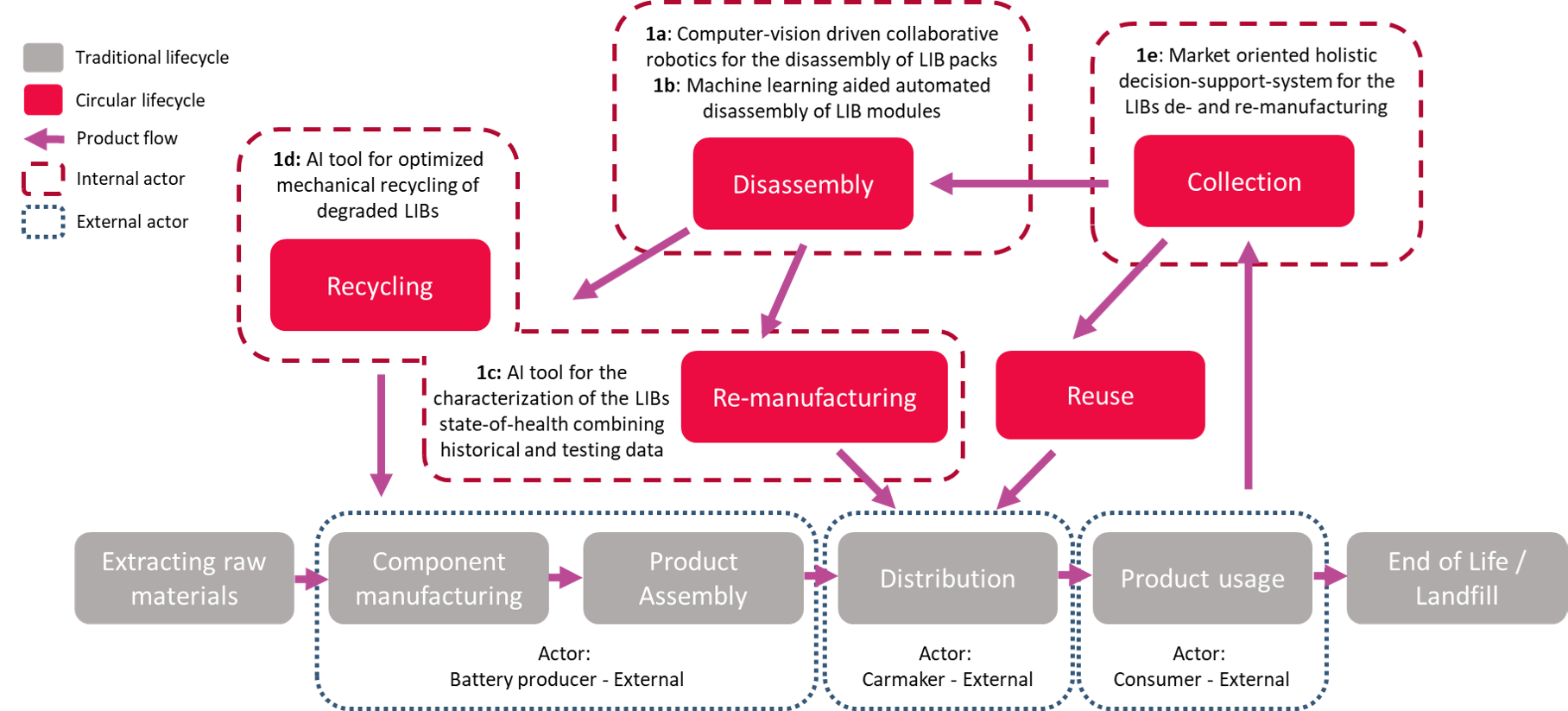De- & Re-manufacturing of Li-Ion battery packs in e-mobility



General Information
Challenge, Value & Description
Performance, Access & Contact
1 – General Information
Partners



Sectors addressed
Application categories covered
Lifecycle level covered
Digital Engineering
Smart Production & Operations
Smart Maintenance
Customer Service
Circularity
https://www.circular-twain-project.eu/use-cases
Geographical Scope
- Europe
2 – Challenge, Value & Description
Challenge
Before the Circular TwAIn Battery Pilot, the end-of-life management of e-mobility lithium-ion batteries was fragmented and inefficient. Manual disassembly, lack of standardized testing, and limited reuse pathways led to excessive recycling and material loss. Valuable cells were often discarded due to inadequate diagnostics, while disassembly processes were time-consuming, hazardous, and unoptimized. The absence of integrated data systems and predictive tools hindered decision-making, reducing profitability and sustainability. This scenario highlighted the urgent need for automation, AI-driven diagnostics, and digital twins to enable smarter, safer, and more circular battery value chains.
Value
After implementing the Circular TwAIn Battery Pilot, the battery de-manufacturing process became faster, safer, and more profitable. AI-driven diagnostics reduced testing time from hours to minutes, while collaborative robotics automated disassembly tasks, cutting labor costs and exposure to hazards. The integration of Digital Twins enabled real-time monitoring and optimization, improving reuse rates and material recovery. A decision-support system guided operators toward the most valuable circular route—reuse, remanufacturing, or recycling—maximizing economic returns. Overall, the pilot increased throughput, reduced waste, and enhanced the sustainability and competitiveness of battery end-of-life management.
Description
In the Battery Pilot, data exchange plays a central role in enabling a more circular and intelligent management of end-of-life batteries. The process begins with the battery manufacturer, who provides essential technical specifications and identification data. This information is uploaded to a federated dataspace, where it becomes securely accessible to other stakeholders, and is also used to initialize the Digital Product Passport (DPP)—a digital twin that tracks the battery’s lifecycle.
As the battery enters use, the OEM (Original Equipment Manufacturer) contributes operational data, such as charging cycles, performance metrics, and early indicators of degradation. This data enriches the DPP and is shared via the dataspace, allowing downstream actors to assess the battery’s condition.
When the battery reaches its end-of-life phase, a logistics provider transports it to a dismantling facility, updating the dataspace with real-time information about handling conditions, location, and safety status. Upon arrival, the authorized dismantler begins the disassembly process, recording each step and identifying components that may be suitable for reuse or recycling. These insights are fed back into the dataspace and DPP.
Next, a testing facility performs diagnostic evaluations, including AI-based State of Health (SoH) predictions. The results are uploaded to the dataspace, providing critical input for decision-making. Based on this data, a remanufacturer may select viable cells for second-life applications, updating the DPP with the new configuration and performance expectations.
If the battery or its components are deemed unsuitable for reuse, a recycler accesses the dataspace to optimize material recovery. They report back on the quantities and types of materials reclaimed, contributing to environmental impact assessments and compliance reporting.
Throughout this process, the dataspace acts as a secure, standardized platform for data exchange, while the DPP ensures traceability and transparency across the battery’s lifecycle. Together, they enable smarter, safer, and more sustainable decisions at every stage of the value chain.
Data Value Chain Description

Infraestructure Elements
- Data Centre
3 – Performance, Access & Contact Info
Performance
In the Battery Pilot of the Circular TwAIn project, several structural challenges in the end-of-life management of e-mobility batteries have been addressed and significantly improved.
Previously, the disassembly process was manual, slow, and hazardous for workers, often leading to the loss of valuable materials. The lack of reliable diagnostic tools made it difficult to assess the true State of Health (SoH) of battery cells, resulting in premature recycling of components that could have been reused. Moreover, data was fragmented across stakeholders, limiting traceability and making it hard to make informed decisions.
The pilot introduced a series of innovations that transformed this scenario. AI models were developed to estimate battery SoH quickly and accurately, enabling better sorting between reusable and recyclable cells. Collaborative robots were deployed to automate disassembly, improving safety and reducing operational time. A federated dataspace and a Digital Product Passport (DPP) were implemented to enable secure, standardized, and selective data sharing among manufacturers, logistics providers, dismantlers, testing facilities, remanufacturers, and recyclers.
The benefits are substantial: increased operational efficiency, reduced costs, improved worker safety, and higher reuse and recycling rates. Most importantly, the pilot demonstrated how digitalization and AI can drive a more circular, sustainable, and economically viable battery value chain.
Lessons Learned & Observations
The Battery Pilot revealed several important insights into how digital technologies can transform the end-of-life management of lithium-ion batteries. One of the first lessons learned was the critical importance of data quality and availability. The success of AI models for predicting battery health depended heavily on having access to consistent, well-structured data from across the battery’s lifecycle. This highlighted the need for early collaboration with data providers and the adoption of common standards.
Another key takeaway was the value of automation. By introducing collaborative robotics into the disassembly process, the pilot significantly improved both safety and efficiency. However, it also became clear that robotic systems must be flexible enough to handle the wide variety of battery designs found in the field.
The implementation of a federated dataspace and a Digital Product Passport (DPP) demonstrated that technical solutions alone are not enough. Effective data sharing requires clear governance, trust frameworks, and role-based access controls to ensure that stakeholders can collaborate securely and confidently.
Perhaps most importantly, the pilot showed that circularity cannot be achieved by optimizing isolated steps. True impact comes from connecting data and decisions across the entire value chain—from manufacturers to recyclers—enabling smarter reuse, remanufacturing, and recycling strategies. This systemic approach is essential for unlocking both environmental and economic value.
Finally, the pilot underscored the need for evolving business models. Circular practices can be profitable, but they require incentives that reward reuse, transparency, and collaboration. The Battery Pilot proved that with the right tools and mindset, digitalization can be a powerful enabler of a more sustainable and resilient battery ecosystem.
Replication Potential & Feasibility Assessment
The pilot’s modular architecture—combining AI-based diagnostics, robotic disassembly, and federated data sharing—makes it highly adaptable to different battery types (e.g., stationary storage, consumer electronics) and geographic regions. Its reliance on open standards and interoperable platforms (like the dataspace and Digital Product Passport) supports scalability across the EU and beyond. Moreover, the pilot aligns with emerging regulatory frameworks such as the EU Battery Regulation, which further enhances its relevance and replicability.
